
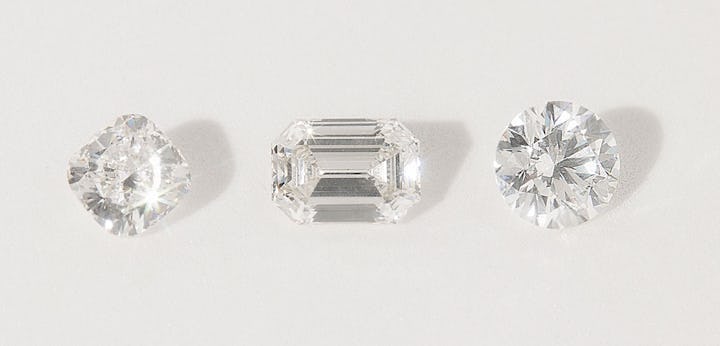
The 4Cs Of Diamonds: Your Ultimate Guide
Kimberly Zerkel | October 05, 2023
The 4Cs of diamonds — cut, color, clarity, and carat - capture the most details about any diamond. The 4Cs define a diamond's quality, brilliance and how it reflects light. Understanding the 4Cs helps you find the perfect diamond for you and assures you of its value.
Studying the 4Cs in-depth is both fascinating and daunting. Explore our ultimate guide of the 4Cs and discover exactly what you need to know to find the lab-grown diamond engagement ring of your dreams.
When you begin the search for an engagement ring featuring VRAI's lab-grown diamonds, it’s easy to focus on the ring’s overall design and aesthetic. But before finalizing your purchase, pay attention to the details of the diamond itself to make the best purchase possible.
What Are The 4Cs Of Diamonds?
The 4Cs of diamonds are cut, color, clarity, and carat weight. They are considered the international standard of measuring a diamond’s beauty and value. Each C has a specific way of being measured and graded. Their quality is recorded in a diamond grading report.
What Is Cut?
The first C is cut. The most important thing to remember about a diamond’s cut is that it is not the same thing as its shape. A diamond’s cut refers to the arrangement of its facets. The cut is considered the most important of the 4Cs because it’s what delivers a diamond’s much-desired brilliance.
When a diamond’s proportions are cut to exacting precisions, light enters and exits the diamond through the same surface, the table. Most diamonds are cut into one of three styles: brilliant (a mix of triangular and kite-shaped facets), step (composed of rectangular facets) or mixed (a combination of both brilliant and step cuts). Each cut is evaluated on the diamond’s “face-up” appearance, and its balance of proportions, durability, polish, and symmetry.
VRAI’s cutting and polishing studios are full of true artisans and each diamond sustainably created in our own zero-emission foundry is inspected more than 1,300 times from when the diamond seed is placed into a reactor to the finished ring. VRAI created diamonds are cut to perfect proportions and are graded on a scale ranging from Ideal + Hearts, Ideal, and Excellent.
“We prioritize cut above all else in our diamonds, so they all will fall in the Excellent range —or better!” says Grace Taylor, VRAI’s Director of Sales. “ We think about this element so you don't have to,” she adds.
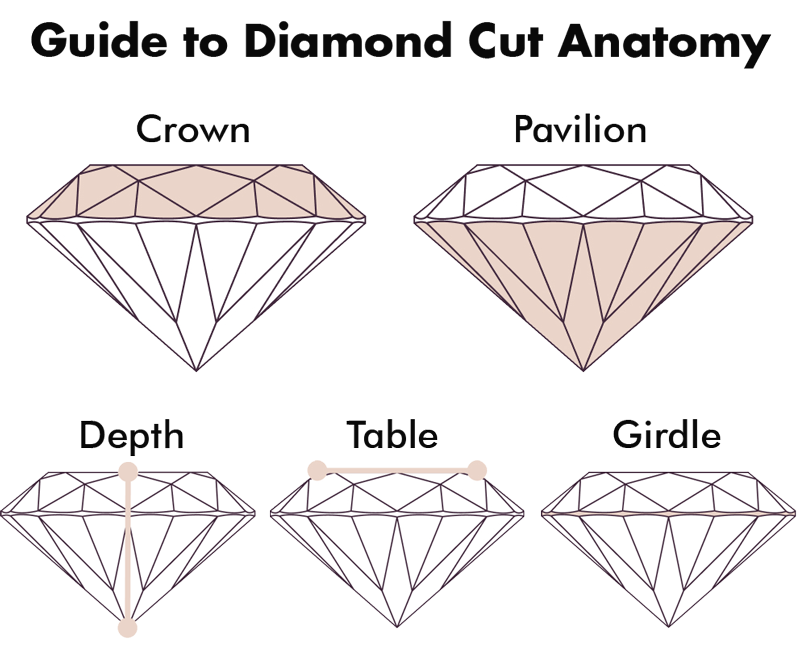

Diamond Cut Reflection
Kimberly Zerkel | October 05, 2023
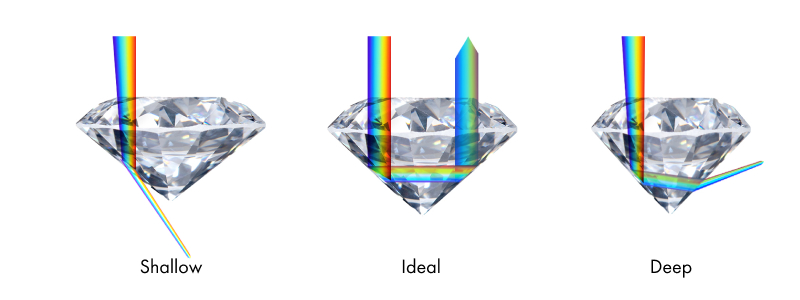

What Is Color?
The second most important of the 4Cs, color, is a reference to the absence of color in a diamond. Diamonds come in a variety of hues, but truly colorless white diamonds are rare, as most have a slight hint of yellow. The closer to colorless a white diamond is, the rarer and more valuable it becomes.
Starting from D, meaning colorless, the scale follows the alphabet downward. Colorless to near colorless diamonds appear clear on the scale, and sit in a range of D through J. Anything beyond J is where slight amounts of pale yellow begin to show through.
Color impacts a diamond’s overall appearance. VRAI only offers colorless and near colorless sustainably created diamonds ranging from D-J on the color scale. At this level, color differences are difficult to detect unless compared side-by-side.
How do you choose color?
“Color is the most dependent on your setting style - warmer gold rings or solitaire styles with no diamond accents will allow you more breadth when it comes to color, but if you are opting for white gold or platinum or a ton of diamond detailing you may want to pay more attention to the colorlessness of your diamond,” Grace emphasizes.
Diamond Color Gradient
Kimberly Zerkel | October 05, 2023


Diamond Color Scale
Kimberly Zerkel | October 05, 2023


What Is Clarity?
A diamond’s clarity refers to the visual purity of a diamond. It is determined by the number of inclusions or imperfections in the diamond and is difficult to notice without the help of a magnifier.
These inclusions occur naturally during the diamond growth process and are what make each diamond unique. The internal spots and lines can affect how light passes through the stone, obstructing the refraction and return of light. This can impact how “cloudy” a diamond appears.
Five factors are considered when assigning a diamond’s clarity grade. The size and number of imperfections, their position within the diamond, how they impact its durability, and the noticeable contrast between the imperfections and the diamond itself.
VRAI offers a wide selection of diamonds sustainably created in our zero-emissions foundry with high clarity grades of VS2 and above that are without any eye-visible inclusions to deliver maximum brilliance. And for diamonds with clarity grades of SI1 and SI2, our graduate gemologists can provide an eye-clean assessment, as the visibility of the inclusions vary depending on the diamond cut and shape.
How do you choose based on clarity?
“Clarity is assessed under 10x magnification so it is the most removed from human eye perception of the four 4Cs,” Grace says. “You want to make sure your diamond is eye clean, meaning no inclusions are visible to the naked eye. Anything higher than that will increase your diamond's rarity but not make a visual difference.”
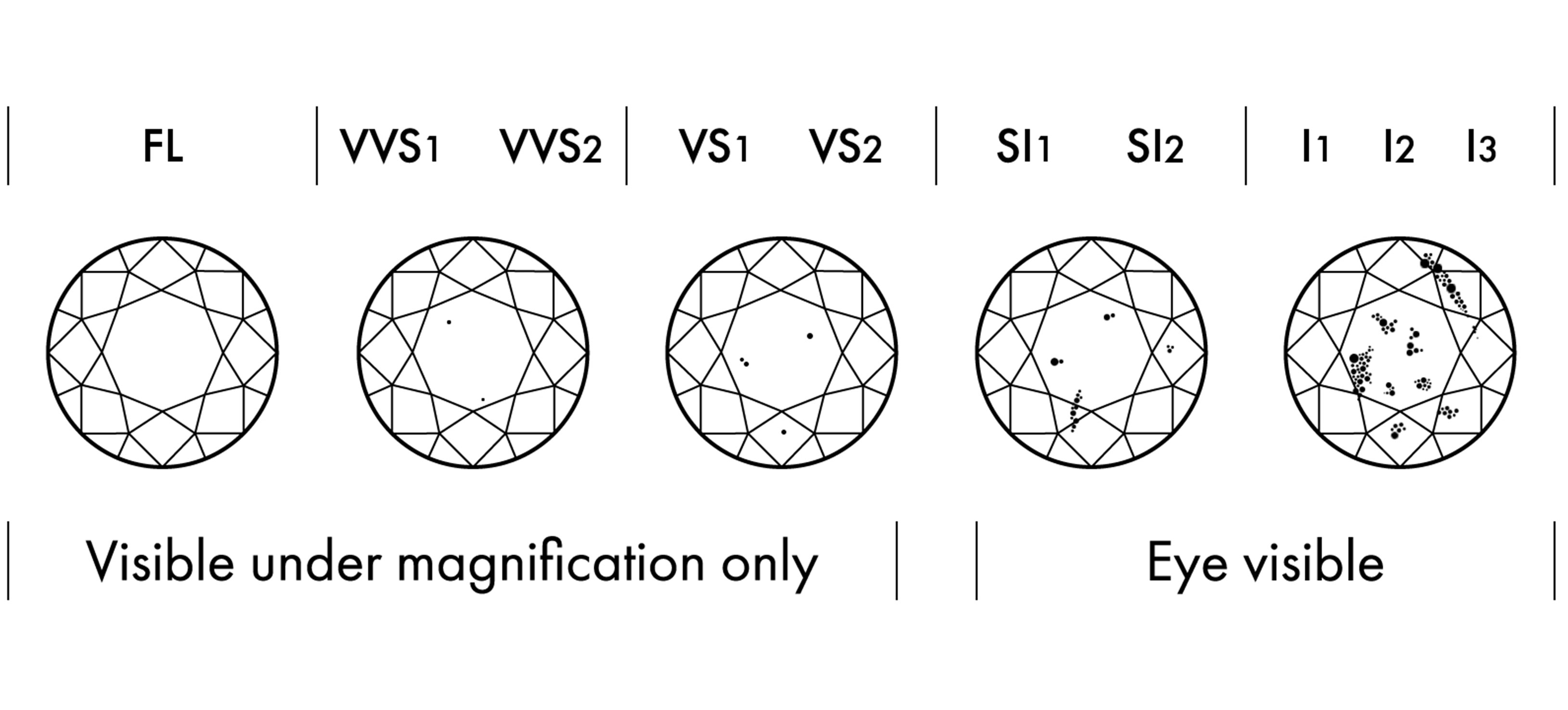
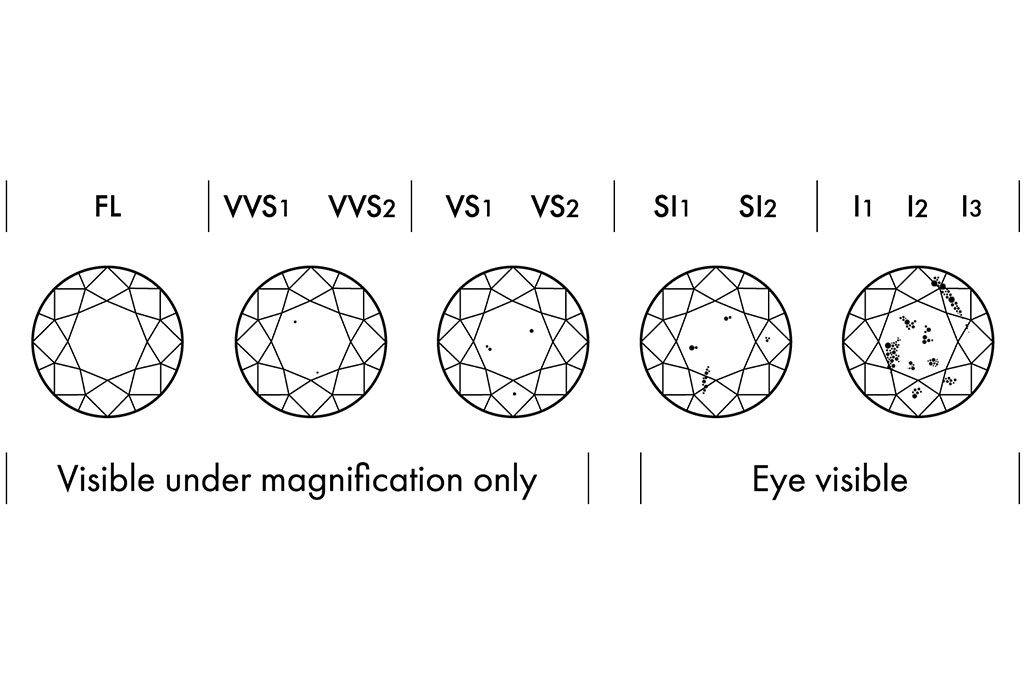
What Is Carat Weight?
A diamond’s carat refers to its weight, not size. One diamond carat is equal to 0.2 grams—roughly the weight of a paperclip. If carat is the most well-known “C,” it is because it can look different from diamond to diamond and shape to shape.
When it comes to carat weight, bigger isn’t always better. The way a diamond is cut can influence how large it appears. In fact, a higher carat diamond with a poor cut can appear smaller than a lower carat diamond with a high-quality cut.
VRAI’s innovative technology allows us to create diamonds from less than a carat to more than 5 carats, which are then cut to maximize beauty at every carat weight.
And selecting based on carat weight?
“More than anything, carat weight is a personal preference — it will also vary by diamond shape. When picking the right carat, keep in mind that your engagement ring needs to bridge the gap of being dressed to the nines on your wedding day as well as your day to day jeans and a t-shirt,” Grace concludes.

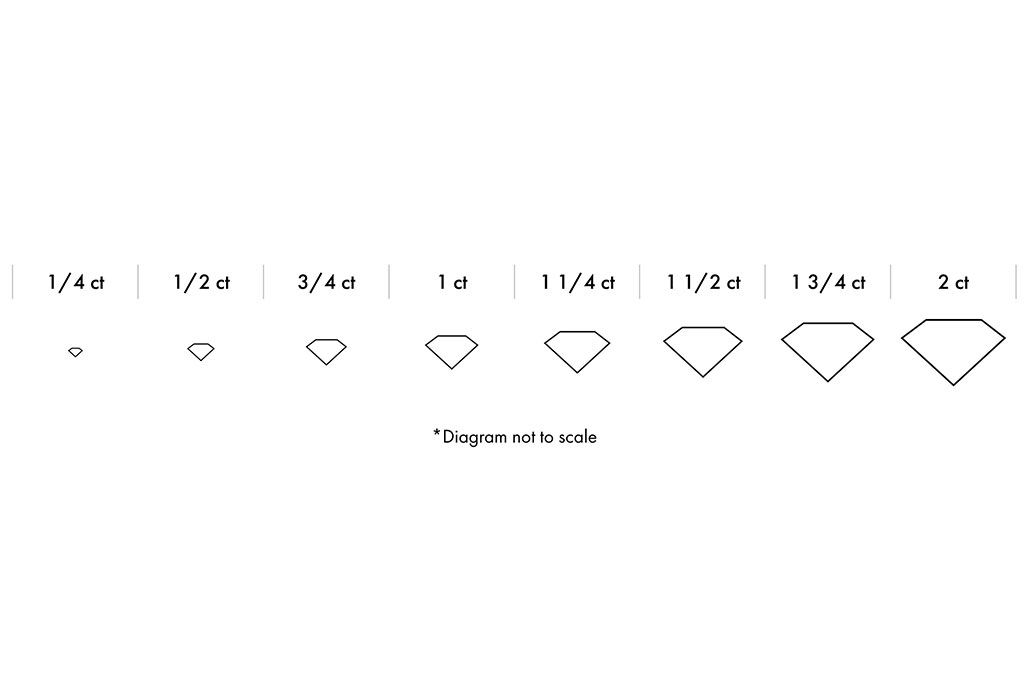
Why Do The 4Cs Matter?
The 4Cs matter because they directly impact the overall look and value of your diamond. Before the 4Cs were adopted as an international standard, diamond merchants could sell their product based on personal bias or ammature grading. This often meant that consumers were paying more for an inferior product.
With the 4Cs and diamond certification, you can rest assured that the value of your diamond is directly linked to its quality.
What Is Diamond Grading?
When diamonds are graded according to the 4Cs, these grades determine the quality and value of a diamond. Once a diamond’s 4Cs have been assessed by a gemologist, they register this information in a diamond grading report.
Diamond certification and diamond grading are often used interchangeably as both refer to evaluating the quality and value of a diamond.
At VRAI, however, a diamond certificate goes beyond documenting a diamond’s quality and value based on the 4Cs. The VRAI Diamond Certificate guarantees all grades. We grade using advanced science-based technology to generate over a billion data points per carat of diamond grown. This gives a comprehensive advantage for judging the quality of a VRAI created diamond crystal, surpassing industry standards.
Because we believe so strongly in our science-based graded characteristics on our VRAI Diamond Certificate, we offer a Lifetime Warranty and a Diamond Value Guarantee.
How Do You Choose Diamonds Based On The 4Cs?
One of the best ways to choose a diamond based on the 4Cs is to book an appointment with diamond excerpts. Based on your setting and preferred diamond shape, they’ll help you select the perfect diamond to complete your look.
When browsing VRAI’s diamond inventory online, you may set filters for clarity, shape, and more. You may also set a budget. Once you’ve selected the perfect diamond according to your criteria, simply add to your bag with the click of a button.
What Are The Best 4C Grades For A Diamond?
Each of the 4Cs has a “top” grade that certifies excellent quality and high value. But certain grades matter more depending on a diamond’s shape, what kind of style it will be featured in, and the metal color it will be set in. It’s important to balance the best diamond grades with your specific needs to find the diamond that’s right for you.
The best grade for diamond cut is “excellent.” For Round Brilliant VRAI created diamonds, VRAI uses “Ideal + Hearts” for its best cut grade. Achieving this grade requires three times as much polishing labor and is the highest possible grade for a Round Brilliant diamond.
The best grade for diamond color is “D.” However, individual letter grades are difficult to distinguish by the human eye, even when comparing side-by-side.
The best grade for clarity is “VVS” (Very, Very Small Inclusions). A diamond with this grade has a minimum light loss and maximum scintillation. Our foundry maintains control of impurities at the gaseous level, resulting in any imperfections after the growth phase to be considered minute and are extremely difficult for a skilled grader to locate under 10x magnification.
There is no “best” grade for carat weight, but VRAI created diamonds are available in larger stones depending on the shape.
What C Is Most important?
A diamond's cut is usually considered the most important C. It directly influences a diamond’s brilliance. A diamond with a poor cut will reflect the light poorly; this in turn can make a diamond appear smaller or duller. An excellent cut will properly reflect and refract the light, revealing its beauty. Its color, clarity, and carat weight will all be affected by this one C.
How Do The 4Cs Work Together?
The 4Cs all work to affect the overall appearance of a diamond. One C can have a direct impact on the others. For example, poor quality cut, color, and clarity can make a diamond appear smaller, regardless of its carat weight.
What Is The 5th C?
The 5th C is carbon neutral!
VRAI's lab-grown diamonds are made by converting greenhouse gas in our zero-emissions foundry. This achievement is made possible by utilizing hydropower, a clean and renewable source of energy. We are experts when it comes to cut, color, clarity, and carat - but our zero carbon footprint is what we love sharing with you the most.
Atomically identical to those from the earth, our diamonds are a thoughtful reminder of your values and a symbol for a more ethical and sustainable future.
Speak With Our Diamond Experts
For in-depth diamond education and guidance in finding the VRAI created diamond meant for you, book an in-person or virtual appointment with our diamond experts. They will guide you through our diamond inventory and help you select a setting to highlight the diamond of your choice.

